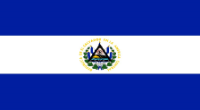Context of the Civil War
 The Weight of All Things chronicles through fiction how ordinary citizens were often caught as collateral damage in El Salvador's Civil War.
The Weight of All Things chronicles through fiction how ordinary citizens were often caught as collateral damage in El Salvador's Civil War.
Central America proved to be an active and tragic staging ground for Cold War proxy battles between the U.S. and the Soviet Union. Civil wars in El Salvador, Guatemala, and Nicaragua erupted due to local political realities developed into secondary fronts between the democratic U.S. and communist Soviet Union. United States officials feared the spread of communism and actively opposed guerrilla, communist revolutionary groups by providing money, resources, and military training to anti-communist regimes. The Weight of All Things chronicles through fiction how ordinary citizens were often caught as collateral damage between the military battles of the Salvadoran government regime (backed by the U.S.) and the guerrilla group FMLN (backed by Cuba, Nicaragua, and the Soviet Union).
Causes of War
El Salvador's civil war grew from longstanding political and economic tensions that spanned decades of authoritarian regimes. The history of El Salvador is one of repeated struggle over land. The economic hardships and violence experienced by many Salvadorans in the 20th century grew from recurring historical patterns of agricultural production, and of rural land use and tenure. Salvadoran elites protected their power by resisting economic reform throughout the 20th Century. Disputes over the use of land in 20th-century El Salvador divided the Salvadoran people, and efforts to reform or change the status quo of land use and distribution corresponded to repeated patterns of violence and conflict in the country.
Cold War Complications
El Salvador’s civil war is an example one of the many violent proxy wars that occurred throughout Latin America during the Cold War between the United States and the Soviet Union (USSR). The presence of the U.S. is presented in subtle and contradictory ways in The Weight of All Things (as you read the story be sure to note the people—and objects!—that represent the U.S.). A good description of how the U.S. government provided military and economic support to the Salvadoran government before and during the civil war can be read from The Salvador Option: The United States in El Salvador, 1977-1992 by Russell Crandall.
Timeline
Nicolás’ story is framed by significant historical events, beginning with the violence that erupted at the funeral of Archbishop Óscar Romero on March 30, 1980, and concluding with the Sumpul River massacre on May 13, 1980. These bookend events highlight a particularly intense period of violence and repression enacted by the Salvadoran military and government security forces against Salvadoran civilians; and they mark the moment when diverse groups joined forces to form the FMLN (Farabundo Martí National Liberation Front). For a chronology of El Salvador’s civil war, read the linked excerpt from Elisabeth Wood’s book Insurgent Collective Action and Civil War in El Salvador. For a longer timeline that also identifies key events before, during, and after the civil war, refer to this link from the BBC news.